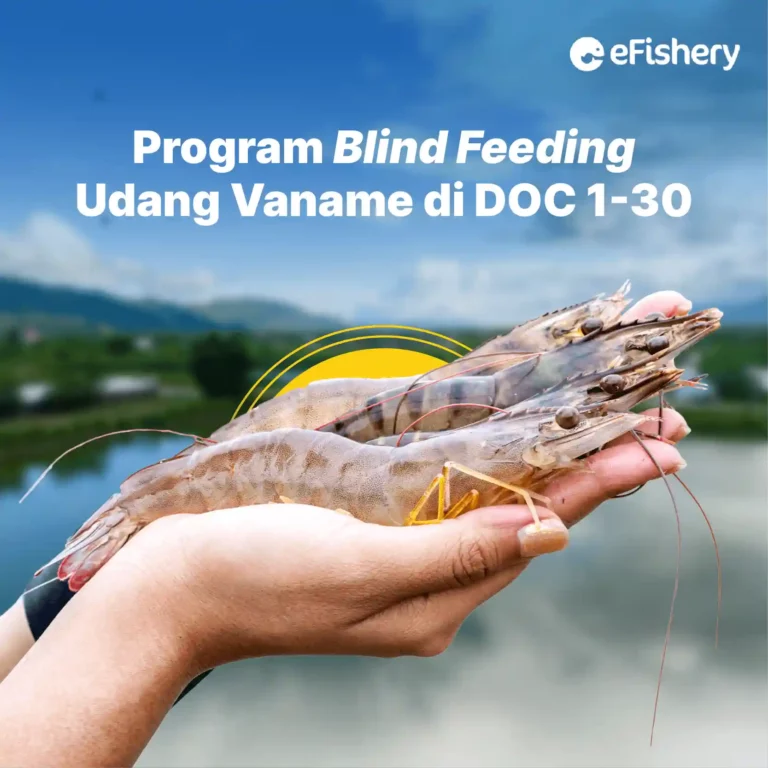Artikel Ini Telah Direview Oleh:

Eko Afriantoro
Praktisi Budidaya Udang
Blind feeding Vaname shrimp is one of the feeding methods given at the beginning of cultivating shrimp. In shrimp farming, the method of feeding is one of the efforts in managing feed so that the use of feed becomes more optimal. Check out the full explanation here!
Feeding Method
The feeding method is one way of managing feed which is expected to maximize growth and reduce feed costs in shrimp farming. Feeding methods are divided into 2 (two), viz Blind feeding And Demand feeding. The application of this method is based on the age and need or appetite of the shrimp. The following is a table of feeding methods based on DOC:
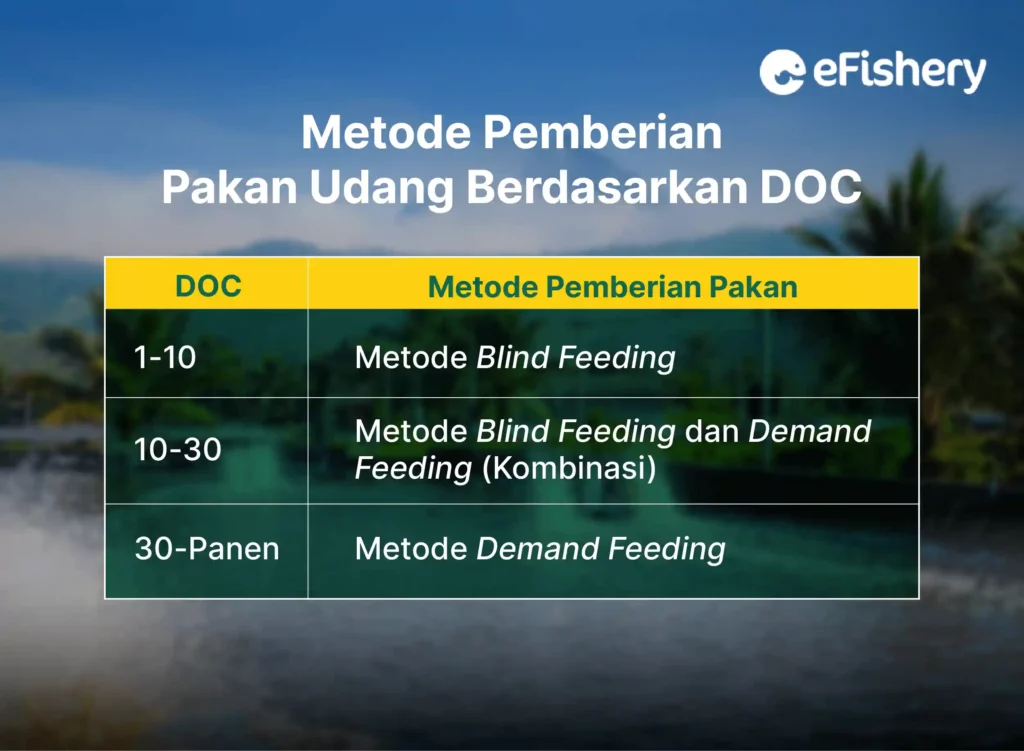
Based on the table of feeding methods above, it can be seen that the feeding program Blind Feeding used for DOC 1-30 where use will be combined with method Demand Feeding. The aim is to adjust the shrimp to switch feed programs based on estimates (Blind Feeding) to a sampling-based feed program (Demand Feeding). Then, the shrimp will be given a method Demand Feeding at DOC 30 until harvest.
What's that Blind Feeding?
Blind feeding or blind feed is an estimated method of feeding done to aged shrimp day of culture (DOC) 1-30. The application of this method is independent of the feed program and depends on the availability of natural feed. Usually the feed in the ponds becomes fertilizer for water and the rest is used as shrimp feed.
In the initial phase of rearing, shrimp prefer to eat natural food because it fits the shrimp's mouth opening. The intended use blind feeding is to obtain a shortcut or survival rates (SR) is high, shrimp size is evenly distributed and as the first introduction of fry on artificial feed.
Program Blind Feeding for Vaname Shrimp in DOC 1-30
Program blind feeding Shrimp is usually given DOC 1-30 shrimp, then combined with the method demand feeding on DOC 10-30. Determination of the amount of feed blind feeding based on the number of fry stocked, growth, survival rate (SR) of targeted shrimp, target FR (Feeding Rate, percentage of shrimp feed requirement per day based on MBW/ABW) and the adequacy of natural feed available in the pond.
Shrimp Nutritional Needs at DOC 1-30
Shrimp nutrition is one of the important factors that must be available in feed to help maximize shrimp growth, especially post larvae or shrimp fry. Some important nutritional components that must be available in shrimp feed include protein, fat, carbohydrates, vitamins, and minerals which can be seen in the following table:
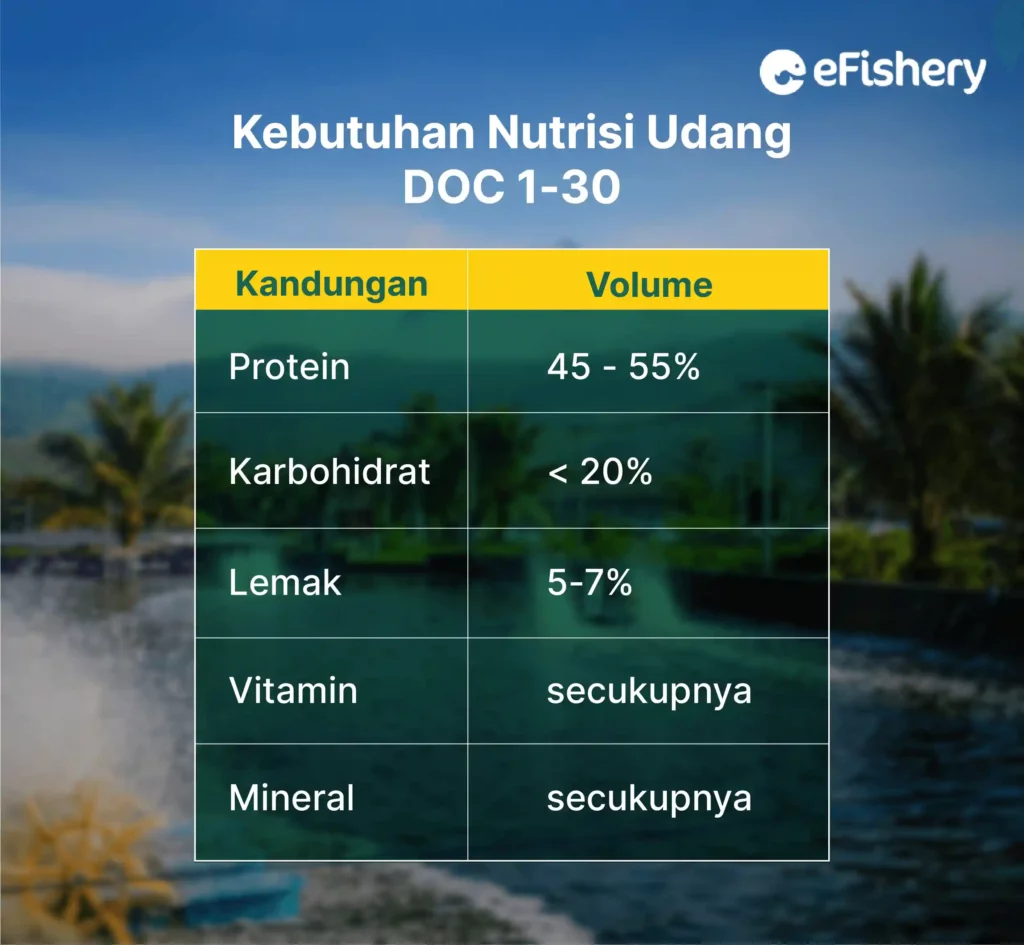
At the beginning of rearing, shrimp need around 45-55% protein to help their growth. The need for carbohydrates for shrimp fry to achieve optimal growth is lower than 20%.
Usually, the fat content in vannamei shrimp feed is around 5 – 7%. Provision of vitamins and minerals is given sufficiently depending on the needs and conditions of the shrimp. Some types of vitamins needed by shrimp include; vitamin A, vitamin D3, vitamin E, vitamin K, vitamin B1, vitamin B12 and vitamin C.
While minerals are divided into 2, macro minerals and micro minerals. Macrominerals consist of calcium (Ca), magnesium (Mg), sodium (Na), potassium (K), phosphorus (P), chloride (Cl) and sulfur (S). While micro minerals consist of iron (Fe), zinc (Zn), manganese (Mn), copper (Cu), iodine (I), and others.
Type of Shrimp Feed Used for the Program Blind Feeding
The type of shrimp feed (usually more specific to feed number) is given to shrimp by adjusting the opening of the shrimp's mouth, so it is important to determine the type of feed according to the age and target ABW/MBW of shrimp. The following is a species table and feed guide for the program blind feeding with a spread of 100,000 fry in an intensive cultivation system:
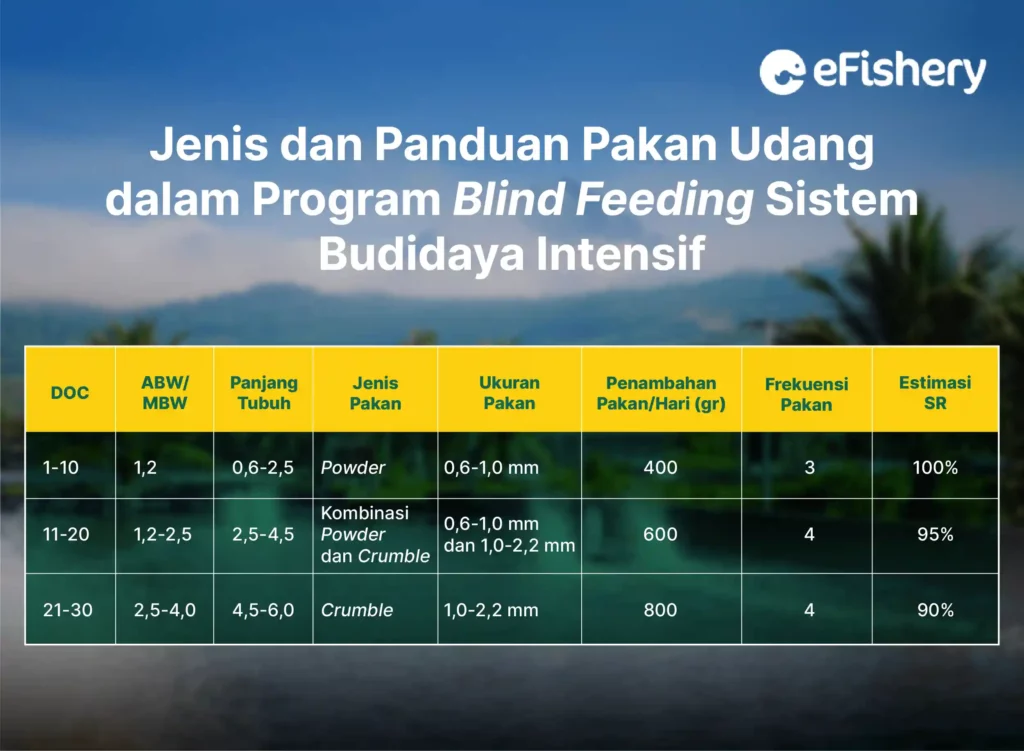
Based on the table above, it can be seen the type of feed that is suitable for DOC, where DOC 1-10 are given feed in the form of powder or powder. DOC 11-20 fed combination feed powder And crumbles or pellets. Then, DOC 21-30 was fed in the form of crumbles or pellets.
So that feeding is more in line with the needs of shrimp feed, you can observe the shrimp intestines when the shrimp can be observed using anco. If the shrimp intestines are full of food, then the amount of feed given is sufficient. When the amount of feed given is appropriate, the estimated SR is also appropriate
Table of Amount of Feeding for Vaname Shrimp Benur
In a state of flux outbreaks AHPND, farmers usually use 2 kg/100,000 PLs (fry fry) in the initial feed to avoid AHPND attacks with the addition of 0.2 kg of feed (during DOC 1-10), 0.4 kg (during DOC 11-20), and 0. .6 kg (during DOC 21-30). Thus, the cumulative amount of feed DOC 1-30 is obtained, which is 200 kg
The amount of feed by method blind feeding then usually refers to the target FCR (Feed Conversion Ratio) in DOC 30. In general, the FCR target in DOC 30 used by farmers is 1:1.
It should be remembered that FCR is the ratio of the cumulative amount of feed compared to biomass. For example, for stocking 100,000 fry in an intensive cultivation system, if you target an FCR of 1:1 using a cumulative feed amount of 200 kg, then the target biomass is also 200 kg.
With a biomass target of 200 kg with a population of 100,000 shrimp, a MBW/ABW target of 0.002 kg can be obtained.
The following is an example of the amount of feeding in the first month (1-30 days) for a spread of 100,000 vannamei shrimp fry in an intensive cultivation system:
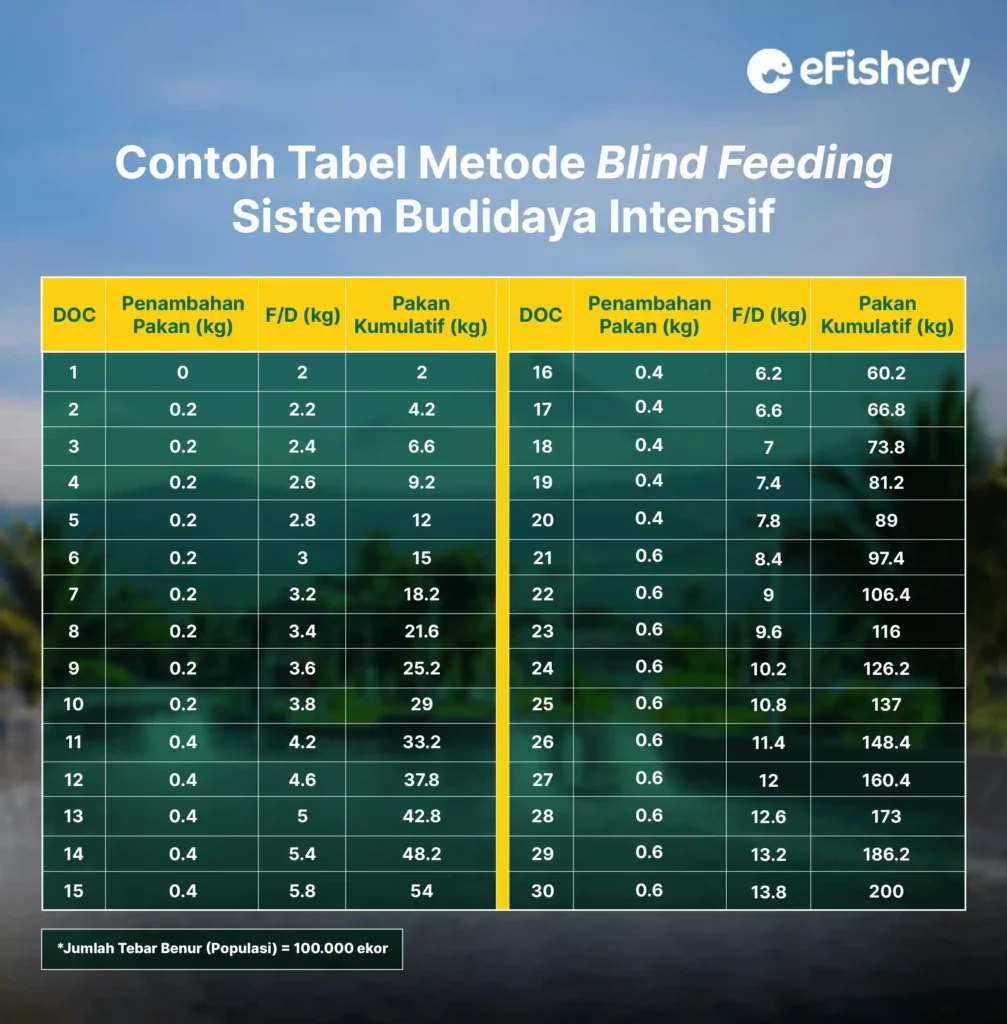
Providing good quality feed, according to the needs and stages of shrimp development will have a positive impact on aquaculture production.
Things to Look For for the Program Blind Feeding
The following are things that must be considered for the program blind feeding:
- Consider the FCR target for DOC 30 and pond conditions before determining the number of feeds per day in the program blind feeding.
- Pay attention to the shrimp ABW/MBW target to determine the amount of feed, because the type of feed (specifically feed number) usually adjusts the opening of the shrimp's mouth. You should not only rely on the DOC in determining the amount of feed, so that the feeding can be in accordance with the current conditions of the shrimp.
- Feed protein is a feed composition that needs to be evaluated after the program blind feeding, because feed protein has a major effect on water quality parameters. For example, if the condition of the water source is too over, then the protein commonly used is 30-38%.
- To supervise the growth of shrimp, you can use the anco sampling method to see the current condition of the shrimp. Farmers usually observe shrimp development only through visuals in the anco. You can also use a shrimp ruler to estimate the MBW/ABW.
- To simplify the conversion from feed to ABW/MBW and ABW/MBW sampling targets, the cumulative feed can be changed to feed/100,000. In addition, it also aims to see %SR. SR can be identified by 3 times sampling, the hope is to optimize feeding and as water quality control in waste management.
- If the FCR target has not been reached at DOC 30, it is necessary to evaluate feed management in the next sampling (sampling is done every 5-7 days) so that decisions are made more quickly and achieve the desired MBW/ABW target, and feed management is carried out more optimally .
Get More Detailed Steps for Blind Feeding Through Cultivation Consultation
Need Help Regarding Shrimp Cultivation Business?
Fill in your personal data in the following form. Our team will immediately contact you via the number cellphone attached. Make sure the data entered is correct.
Blind feeding is the provision of feed at the beginning of cultivation maintenance. Therefore, more detailed steps are needed such as determining the number of stockings, growth targets, and other supporting optimizations before determining blind feeding, or Mr / Ms can directly consult related blind feeding through Cultivation Consultation on application eFarm.
eFarm is an application that can help farmers to solve shrimp farming problems with features Cultivation Consultation. Cultivation Consultation is one of the features in the app eFarm which you can use to consult on cultivation issues which will be answered directly by a professional aquaculture expert.
So what are you waiting for? Consult cultivation problems right now!

Eko Afriantoro - Praktisi Budidaya Udang
Eko berpengalaman sebagai praktisi budidaya udang sejak tahun 2013 yang kini menjadi Farm Lead Research & Development (R&D) Shrimp eFishery.
Questions Regarding Vaname Shrimp Blind Feeding
Blind feeding or blind feed is an estimated method of feeding done to aged shrimp day of culture (DOC) 1-30.
The type of shrimp feed given to shrimp must adjust the opening of the shrimp's mouth so that the feed is not wasted. The type of feed in DOC 1-10 is powder, DOC 11-20 feed type is combination powder And crumbles, while the type of feed DOC 21-30 is crumbles or pellets.
- Akmal, Y., R. Humairani, M. Muliari and I. Zulfahmi. 2021. Increased Economic Value in the Sea Mina Cultivation Group of Vaname Shrimp (Litopenaeus vannamei) Bireuen District, Aceh. Solma's Journal. 10(02): 275-286.
- Iskandar, A., Wandanu, D., and Muslim. 2022. Vaname Shrimp (Litopenaeus vannamei) Growing Production Techniques: A Case Study at PT. Goddess of the Sea Aquaculture Garut. NEKTON: Journal of Fisheries and Marine Sciences,. 2(2): 1-13.
- Kaligis, E. 2015. Growth response of vannamei shrimp (Litopenaeus vannamei) in low salinity media with different protein and calcium feeds. Journal of Tropical Marine Science and Technology. 7(1): 225-234
- Mansyur, A., M. Mangampa, HS Suwoyo, B. Pantjara and R. Syah. 2014. Feed management strategies for vannamei shrimp (Litopenaeus vannamei) cultivation. Research and Development Center for Brackish Water Cultivation. 37 p.
- Purba, CY 2012. Growth performance, survival, and nutritional content of vanamei shrimp larvae (Litopenaeus vannamei) through feeding artemia locally produced which is enriched with diatom cells. Journal Of Aquaculture Management and Technology. 1(1) 102-115
